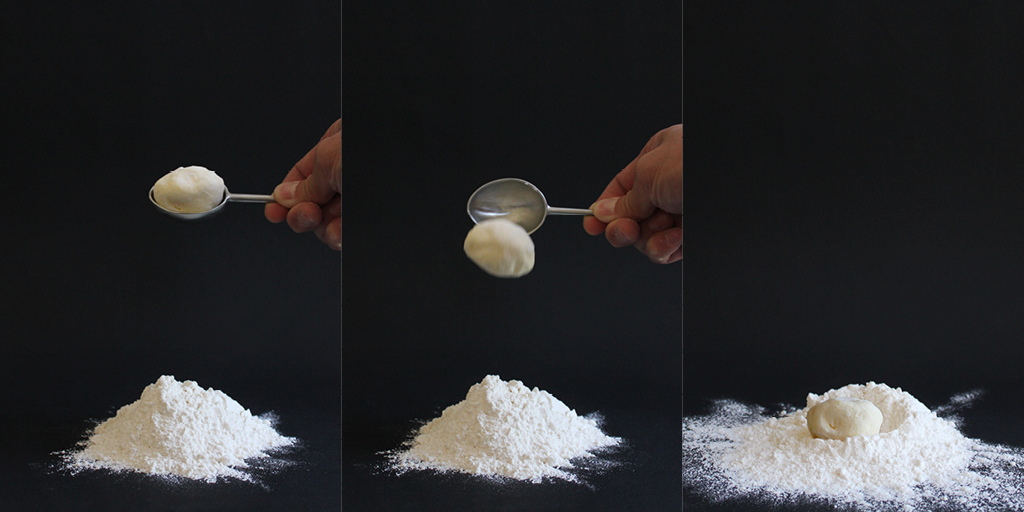Before standard measures were created, recipe books referred to sizes in relation to objects found in nature, e.g. an “egg-sized lump of butter.”

Before standard measures were created, recipe books referred to sizes in relation to objects found in nature, e.g. an “egg-sized lump of butter.”
What if we revived the times before standardization, with a series of measuring spoons using the natural geometries and volumes of bird eggs?
Basing the eggs on official “state birds” across America gives a nod to the tradition of souvenir spoons.
Cast in lead-free pewter in Northern California.
The spoons’ natural, non-concentric forms subtly underscore their pre-industrial origins.
Commissioned by the Center for Craft, Creativity & Design to be used at an annual dinner.
We inherit precious plates, bowls and glasses as heirlooms, and pass them on to future generations. But what happens in today’s world where new cultures and foods renders yesterday’s servingware obsolete? Where is the soy sauce pourer in grandmother’s china set?
Valence creates a new ritual in heirlooms. It’s a system where new typologies of objects can be created using an alphabet of simple forms – from a single mold.
A meeting of old and new: the glass-blowing mold is crafted in cherry wood, the traditional material for glass making, and shaped with advanced computer aided design and manufacturing methods.
The mold is what you pass on. The method of creation gets its turn in the spotlight. You reconfigure the mold to make the object you want.
Valence adapts to create new objects according to your wish. One mold, many possibilities. Today and tomorrow.
Torrey is a place to rest for a while, before moving on with our busy lives. It is an embrace of dueling currents in California culture: nature and technology. Windswept coastal pines are the point of departure; their forms, abstracted in the pixilated manner of computer aided design, create a perch with multiple sitting and leaning options. This reflects on the idea of California casual – no one way to sit is prescribed.
The Wilsonart wood grain laminate fits in this meeting of natural and engineered. The material – with its vast variety of colors and grain patterns – “paint” light and shadow across the facets. The laminate helps not to re-create nature, but to re-present it, turning its “faux” qualities into an asset.
Exhibited at ICFF and NeoCon 2012, as winner of the 8th Annual Wilsonart Design Challenge. Cited as a highlight of ICFF by Houzz and Design Milk.
Just like sitting on a tree branch, people find a position they feel is most comfortable for the moment. Candid shots from ICFF.
We all know that wines take up the flavors of the land they are from. How might we bring a sense of place, to the vessel in which the wine is served?
This decanter was designed for the Saracina Vineyard in Hopland, California (John Fetzer and Patty Rock, owners).
The interchange of planes and sweeps reflects the forms and visual vocabulary of the vineyard.
Designed with Rhino and crafted in glass using a wooden mold.
One design, eight tiles, multiple configurations.
Designed to achieve maximum relief in three dimensions, and maximum total plasticity across all configurations.
Initial sketches and configurations.
Crafted in clay with plaster mold.
In a 10-day workshop led by Jaime Hayon, designers were asked to create all-white servingware for a rustic country dinner based on compositions of found objects.
Crafted with slip-cast porcelain with white gloss glaze, at ENSA Limoges.
Dinner is served, for 80 guests.
Ringo teapot inverts solid-volumetric relationship in a minimal, yet functional design.
An investigation into the everyday ritual of breakfast; humor and poignancy are injected into the humble egg cup.
Slip cast porcelain with a white satin glaze.
Wai & Company is a service concept prototyped at Design Academy Eindhoven, to transform a cold transactional interaction into a social exchange.
The typology of the macaron, a French cookie with two halves, is the platform for sharing. Instead of receiving a macaron with just the flavor of your choosing, half of your macaron is from the customer in front of you. Your chosen flavor in turns becomes half of the customer after you.
Offering a range of flavors from mild (Dutch chocolate) to wild (paprika). This helps each customer express their individuality not only through flavor preference, but also risk profile.
Some customers wanted to keep their flavor choices secret, and deliberately tried not to listen to others’ conversation, in order to make it a surprise. Many customers negotiated with each other about the flavors they would choose. After getting their macarons, they discussed their reactions and sometimes traded their results.